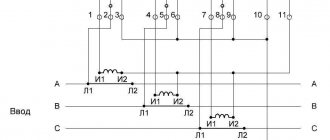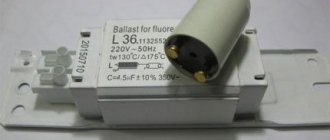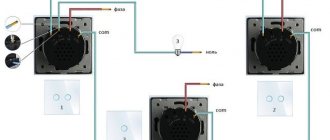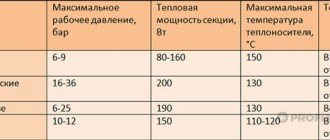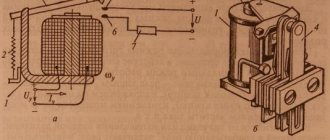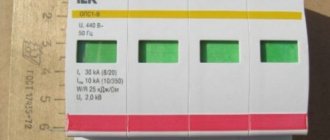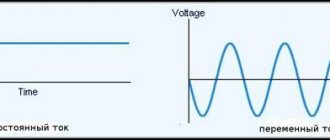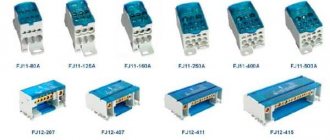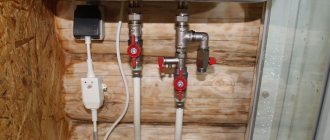Installing a special device for controlling the heating level of an autonomous heating system in a private home reduces fuel consumption by 20%, reduces the load on equipment and increases indoor comfort. Let's look at what a thermostat for a heating boiler is, how it works and what it is intended for, what types of it exist, how to choose the right one for specific application conditions and what are the features of its connection.
Digital room thermostat for heating boiler Source gradusplus.com
Thermostat - what is it, purpose, principle of operation
The thermoregulatory device interacts between the heating heater and the temperature of the atmosphere indoors and outdoors, as well as the level of heating of the coolant, pipes and radiators. In this case, the parameters are set by the user through the control unit.
A typical thermostat consists of the following set of main components:
- Thermosensitive sensor. It is made of a material that changes characteristics under the influence of changes in ambient temperature. The signal from the sensor is transmitted to the control unit.
- Control module. It detects the slightest changes in sensor parameters and issues the appropriate command to the operating mechanism, which directly triggers one or another action in the boiler equipment. This can be a simple mechanical valve or an electromagnetic relay, as well as a digital or analog device.
A temperature-sensitive element connected by a wire to the actuator unit Source par-torg.com
- Settings block. On it, the user sets the temperature values and other parameters at which the thermostat for the heating boiler should operate. In mechanical models, one single setting is performed, in electronic models, several parameters are set simultaneously.
The device operates according to the following algorithm:
- Using the settings block, the user sets the required temperature value.
- As soon as the heating level of the medium reaches the desired value, the control module detects the changes that have occurred in the characteristics of the sensor.
- Next, a signal is sent to the operating mechanism to perform a specific action - stopping the boiler, closing the pipeline valve, shutting off the radiator, etc.
- As the ambient temperature reaches below the set value, the control unit again records the changes in the sensor and starts the system to increase the temperature.
Advice! During the absence of the owners or during night sleep, using a programmable thermostat, you can lower the temperature in the house by 3-4 0C below the normal value. This will reduce energy consumption by 30% compared to the usual consumption rate.
The thermostat ensures a comfortable microclimate in the house no matter the weather surprises Source stroy-podskazka.ru
Setting procedure
To configure the system and select a comfortable temperature, follow these steps:
- Set the maximum temperature using the remote controller.
- Start the boiler and bring it to the optimal operating mode, in which the unit achieves the greatest efficiency.
- When all rooms are at a comfortable temperature, take an electronic thermometer and measure the temperature near your regulator.
- Select the measured value on the thermostat as the heater shutdown threshold. Enter the required settings into the programmer.
Important clarification. The gas boiler operates with maximum efficiency at a temperature range of 80/60 °C (supply/return).
Let us explain the purpose of these manipulations. Due to different areas and heat losses, the temperature in the rooms may differ by 1-3 degrees, so it is better to navigate by the degree of heating of the air near the sensor itself.
If the temperature at the point where the regulator is installed is very different from other rooms, when setting, you need to make an adjustment for the magnitude of this difference. Some models, for example, Baxi Magic Plus, provide a function for such adjustment (called temperature shift). Then all that remains is to enter the desired value into the device’s memory, ranging from 1 to 5 degrees.
Varieties
Household temperature sensors for heating boilers are classified according to several criteria:
- Method of temperature control – mechanical, electromechanical, electronic.
- Boiler type – for electric, gas, solid fuel.
- Installation location - indoor, outdoor.
- Signal transmission method - wired, wireless.
- Number of functions – with one, many (programmable).
Let's look at the features of each variety in more detail.
By temperature control method
Depending on the method by which transformations of the properties of a temperature-sensitive component are transmitted in response to changes in ambient temperature, temperature sensors are divided into the following 3 types:
- Mechanical.
The operating principle of sensors of this type is based on changes in the physical properties of substances under the influence of heating or cooling - namely:
- Expansion-compression of gas or liquid.
- Fluctuations in metal elasticity parameters.
The design of a simple mechanical thermostat Source otoplenie-gid.ru
The design of devices with liquid or gaseous substances is based on a sealed flask. When the heating level changes, the liquid or gas contracts or expands, thereby moving the valve stem or gate. The operation of models based on a metal element is based on the closing and opening of contacts. When heating and cooling, the plate is deformed - supplying or interrupting an electrical signal to the control module.
The main advantages of a mechanical temperature controller for a heating boiler:
- Independence from the state of the external power supply network.
- Simple device and simple design.
- Low cost.
The negative aspects of this type of regulator are expressed in low sensitivity, a fairly noticeable error - up to 20C and bulkiness. Most often they are installed to control the temperature of the coolant in the radiator, but not the air in the room.
To set up a mechanical thermostat, just turn the knob to the desired position Source terman-s.ru
- Electromechanical. The operating principle of this type of regulator is based on the occurrence of a potential difference between interconnected plate elements made of different metals. The signal from them passes to an electromagnetic relay to execute a specific equipment command. Due to low sensitivity, high surface heating is required to obtain a sufficient electrical impulse.
Therefore, their main area of application is flame control in the furnace of a boiler operating on direct combustion of fuel. As soon as the fire goes out, a signal instantly passes to the control unit and security system. At the same time, the device requires constant power supply to operate.
- Electronic. Temperature regulators that require a constant power supply for full operation. They contain an external temperature-sensitive element for monitoring air temperature and a control module. As a rule, electric boilers are equipped with them.
The electronic boiler temperature sensor includes 2 main components:
- Thermosensitive element.
- Microcontroller.
Wireless digital thermostat of two modules Source teplo25.ru
See also: Catalog of companies that specialize in engineering systems (heating, water supply, sewerage and others) and related work
Having received a signal from the sensor, the microcontrolling module executes one or more commands programmed into it. In this case, both elements may not necessarily be located in the same housing, but are separated from each other in space. Communication between them is carried out both wired and wireless.
Depending on the type of technology used, there are two types of electronic sensor:
- Analog. Works according to a strict logical algorithm. The capabilities are similar to mechanical models, but more accurate - the error is no more than 0.5 °C.
- Digital. It operates in both closed and open logic circuits. In the latter case, it allows you to make custom settings and set heating parameters according to a schedule.
Advantages of an electronic sensor:
- Connection of remote sensors, including street ones.
- Highly precise settings.
- Variety of execution options.
Disadvantages: energy dependence and high price.
The electronic temperature sensor is quite accurate, but requires constant power supply Source teploregulyator.ru
On a note! Modern models of electronic sensors can be controlled remotely via a mobile application when connected to a smart home system. For example, you can set the desired level of room heating after a long absence when returning home from work, a trip, or vacation.
By boiler type
Despite the fact that all types of heating boilers are designed for one common purpose - heating rooms, they operate, and therefore are controlled, according to slightly different schemes. Therefore, different thermostats are used for them, having the following features:
- For gas. The thermostat for a gas boiler, as a rule, has a built-in design and is designed to control the temperature of the coolant. However, copies of some lines have the ability to connect external sensors to measure the heating of the surrounding air. The influence of a particular sensor on the operation of the unit is set by the control module depending on the settings.
A modern gas boiler with a built-in thermostat to control the temperature of the coolant Source vaillant.ru
In addition, it is possible to connect an external thermostat in parallel with the built-in one - without a special interface according to the following algorithm:
- The executive module is integrated into the electrical power supply circuit of the unit.
- After this, the required room temperature is set on the sensor.
- When the air temperature reaches the set value, the executive unit will de-energize the boiler.
- As it cools, the thermostat will start the burner.
Gas units in non-volatile design are always equipped with mechanical temperature sensors of the remote type. They only control the operation of the burner. Some models may be equipped with a standard external sensor without the possibility of replacement or addition.
- For electric ones.
Unlike the type of unit described above, the electric boiler is controlled in a large number of ways:
- By disconnecting the power supply.
- Changing the intensity of operation of electric heating elements.
- Impact on the controller.
External thermostat for an electric boiler Source onlinetrade.ru
Which thermostat is better to choose?
To make the right choice of a room regulator, we suggest considering the pros and cons of two types of household appliances. Disadvantages of mechanical models:
- low accuracy of maintained temperature;
- wired connection - the cable will have to be pulled from the boiler room to the desired room;
- lack of various convenient functions available in programmers.
Note. Judging by the reviews of real owners on the forums, the accuracy of temperature maintenance is not a critical problem and does not worry users too much. Another thing is the wires that need to be hidden under the baseboards, in the grooves of the walls, and so on.
There are also three obvious advantages of bimetallic thermostats:
- low price and availability;
- reliability in operation - in the simplest models there is nothing to break;
- ease of control of the boiler using one handle, which is important for older homeowners.
The negative aspects of electronic regulators are a higher price, a not always clear interface and the need to timely replace batteries. Cheap Chinese models encounter an additional problem - a breakdown in communication with the relay unit when installing the control panel behind 1-2 partitions.
An absolute plus of digital thermostats is comfortable operation. It is enough to set the weekly and daily operating program for the heat generator once; no further actions are required.
Wireless programmers need to change batteries on time.
We list a typical set of functions using the Baxi Magic Plus thermostat as an example:
- temperature control range – 5…35 °C;
- protection against freezing of the heating system, by default starts the boiler when the home cools down to +3 degrees;
- LCD display with backlight, control – push-button;
- shift of temperature sensor readings ±5 °C (read the explanation in the next section of the publication);
- 2 operating modes – economical and comfortable;
- hourly/daily/weekly programmer.
Reference. Manufacturers often call such devices digital chronothermostats. The weak point of the devices is their low maintainability in the event of a breakdown, especially Chinese products for which it is not easy to find spare parts.
Knowing the features of electronic and mechanical regulators, it is not difficult to choose the appropriate model. Focusing on your budget, first of all consider reliable products from European, Japanese and Korean brands, there are also decent brands, but on average the quality of the products leaves much to be desired.
Video description
Video example of installing and using a smart thermostat for a boiler:
Helpful information! The thermostat should be mounted in a place to prevent it from being exposed to nearby heating devices, sunlight, drafts, cold bridges, electrical equipment, at a height of about 1-1.5 m from the floor surface.
By signal transmission method
Medium heating meters for a heating unit are divided into 2 types according to the method of data transmission:
- Wired. Connect to the controller via cable.
- Wireless. Data transmission is carried out via a radio channel, and goes from the unit that controls the parameters of the room, that is, the temperature sensor itself, to the receiver unit installed near or on the body of the unit.
Helpful information! In addition to room air heating regulators, there are temperature sensors for measuring the heating level of the coolant used in the heating system. They are produced in overhead and submersible versions. The first ones are installed on the surface of the pipeline and batteries, the second ones are mounted in a special place inside the pipes, and during operation they come into direct contact with the heated liquid medium.
We achieve maximum stability and comfort
An additional feature of many electronic thermostats is the ability to organize weather-dependent control, when the boiler power is adjusted, including changes in the outside temperature. To do this, just connect a universal outdoor temperature sensor to the thermostat (2-2.5 thousand rubles).
External temperature sensor for Gira thermostat 130200.
It consists of a single structure: a sensor and a wire 2-6 m long. Therefore, it is enough just to fix the wire strands in the corresponding contacts of the thermostat, according to the instructions.
Selection rules
When choosing a temperature sensor for a heating boiler, the following installation parameters are taken into account:
- How, where and in what way the regulator will be installed.
- Maximum permissible dimensions.
- Operating range of control and regulation of temperature indicators.
- Sensitivity limit.
- Intended purpose for installation - outdoor, indoor, overhead or submersible.
- Basic and additional functionality.
- Control options – via panel, remote control, remotely.
Connection features
There are 3 standard schemes for connecting a temperature sensor to a heating boiler - these are:
- Directly to the boiler.
- To the pump.
- In front of the radiator on the pipe.
The first two options do not reduce the power of the coolant flow, unlike the third. In the latter case, the thermostatic valve somewhat impedes the flow, thereby increasing the hydraulic resistance in the system. This must be taken into account - since the pipes are designed for a certain maximum pressure.
To avoid an accident, it is necessary in advance - even at the design stage - to include in the circuit all thermostats mounted on pipes and radiators. In addition, it is recommended to install a temperature sensor in front of the battery using a bypass. With its help, the flow will be redirected to the return line while not cooled down - thereby saving energy resources.
Prices: summary table
| Manufacturer and model | Peculiarities | Cost, rub. | Our rating, 0-5 points |
| BAXI KHG | Mechanical, inexpensive and reliable | 1 350 | 3,9 |
| TEPLOCOM TS-Prog-2AA/8A | Programmable, wired, functional, best in price-quality ratio | 3 600 | 4,5 |
| TEPLOCOM TS-Prog-2AA/3A-RF | Programmable, wireless, functional, expensive | 5 500 | 4,3 |
| TEPLOLUX MCS-350 | Programmable, wired, functional, with Wi-Fi module and touch display, with additional. sensor, modern stylish design | 5 200 | 4,9 |
Briefly about the main thing
The thermostat controls the operation of the heating unit in accordance with the user’s settings - based on the air temperature indoors and outdoors, as well as the heating level of the radiators and coolant in the system. Its design includes a temperature-sensitive element, a control module and a settings unit.
As soon as the temperature of the controlled environment reaches the set value, the executive unit sends a command to the equipment - turning off the boiler or pump, closing the valve in the pipe. As it cools down, the reverse command is triggered - the equipment turns on for heating.
Modern models of temperature sensors for heating are classified according to the following criteria:
- Thermal control method.
- I see the boiler.
- Installation location.
- Data transfer method.
- Number of functions.
When choosing a regulator for specific application conditions, first of all, its own technical characteristics and their compatibility with the equipment are taken into account. Installation of devices is carried out in three ways - to the boiler, to the pump and to the pipes. Moreover, their introduction into the scheme should occur at the stage of project creation.
Electric boilers
A fairly common alternative to gas and solid fuel boilers. Lots of advantages, high efficiency, but long payback period. The connection is simple, like with gas boilers, but without a cold water supply. Temperature regulation and overheat protection are provided.
Mechanical boiler timer
Using a simple mechanical timer for an electric boiler, there are three options for starting the central heating system :
- The boiler is turned off;
- The boiler supplies warm water;
- The boiler turns on and off at the set time.
Mechanical timers usually have a large round dial with a 24-hour scale in the center. By turning the dial, you can set the desired time, and then leave it in that position. The boiler will turn on at the right time. The outer part consists of a set of tabs for a 15-minute period, which are inserted for easy adjustment of operation and mode settings. Emergency reconfiguration is possible, which is performed with the boiler connected to the network.
Mechanical timers are easy to set up, but the boiler always turns on and off at the same time every day, and this may not satisfy the owners if the family is large and bathing procedures are carried out several times a day at different times.
